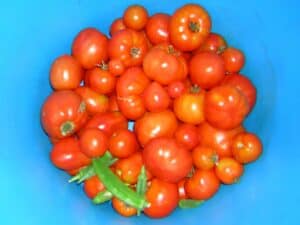
Article and photos by Rob Danforth
Cherry, grape, pear, plum, early maturing, beefsteak, heritage, heirloom … once thought to be poisonous, tomatoes are now a gardener favourite. Of the many flavours, shapes, and colours, gardeners look for the tomatoes with a taste that they prefer and plants that grow best in their situations.
All tomatoes are either ‘determinate’ or ‘indeterminate’.
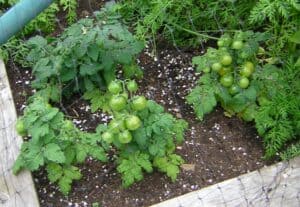
However, the more tomatoes on the plant, the greater the challenge and stress on the plant since fruit and seed production demand a lot of energy. Also taste can suffer.
Starting Indoors
Because Ottawa has approximately 135 standard gardening days – give or take! — start tomatoes 6 to 7 weeks indoors (e.g., 1st week of April) either in a sunny window (6-8 hours) or under full spectrum grow lights for 16 hours per day (T8’s, T5’s, and LED configurations all work well). If this is not possible, then purchase seedlings for transplanting. A flat of 6 seedlings is usually cheaper per plant than the purchase of single plants.
If you use a sunny window, be sure to rotate the plants a quarter turn daily so they do not lean to the sun, and shake them lightly to toughen the stalks or use a gentle fan from time to time. If you use grow lights, raise the plants or lower the lights to keep the light 1 to 2 inches above the plants and never touching! In both methods, bottom watering is best to avoid floating the seeds about in the pot. A good habit is to plant more seed than needed per seed pot in case the seed you plant is not viable. Then, after the 2nd set of true leaves on the plants, scissor out the weakest at soil level and let the strongest plant grow on.

After 4 weeks in a small seed pot, it is good to fertilize with a high nitrogen fish emulsion (I use “Muskie”) to encourage green growth. Remove any attempt at flowering.
Of course you can continue to grow indoors under the lights, but when I did this, I had to become the pollinator (small paint brush) and I discovered that growing time was longer and that tomatoes grown in the sun taste much better.
Transplanting Outdoors
First, “harden off” the plants by putting them outside for an hour in no wind and weak sun. Each day increase the outside time by ½ hour to an hour (depending on warm weather) until the tomato plants are fully acclimatized.
Container choices: soil bag, standard pot, fabric bag, self-watering pot (recommended), or potato bag.
Soil Bag: put a boot tray under a bag of soil. Pierce the underside of the bag multiple times for drainage. Cut 2 or 3 holes in the top surface of the bag and transplant the tomatoes into the soil. Put bamboo tripods over the bag to act as supports for the plants, and make different sized rings of sisal to form the levels or plant ladders.
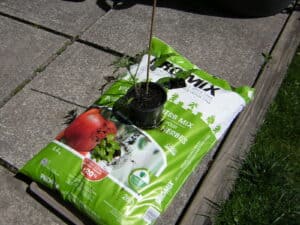
Standard pot with drain holes: wet the pot if terracotta, and put 2 layers of green kitchen scrub pads (no sponge attached!) in the bottom to cover the drain holes. The pads will drain the water, keep the soil inside the pot, and keep the bugs out. Fill with moist potting soil (dry soil shrinks considerably at first watering), and plant the seedling at the same depth in the soil as in the seed pot – unless your container is quite large (e.g., box bed or cold frame) in which case follow instructions for large containers.
Fabric bag, and self-watering pot: Fill with moist soil and transplant the seedling at the same depth as in the seed pot. However, note that fabric bags dry out very quickly, so you will have to be more attentive to the water needs; Self-watering pots have a water reservoir at the bottom to help the plant to draw up water as needed (of course you must fill the reservoir) so it never dries out.
Large containers (potato bag, box bed, cold frame): Plant the tomato seedling deeper than it was in the seedling pot. For example, if the plant is now a foot tall, remove the lower leaves (do not plant leaves under the soil) and plant the tomato 4 or 5 inches deeper to take advantage of the larger root room as well as the moisture deeper down in the soil. Many more roots will sprout from the buried stem.
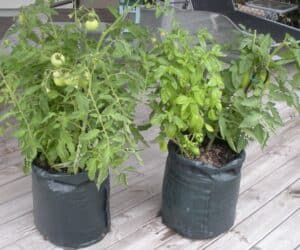
Raised beds, in-ground planting, and floating raised beds.
Raised beds and In-ground plots: In a raised bed, keep the soil level in the bed and plant the tomato deep. For in-ground planting, you have choices: keep the soil level and plant the tomato deep, or create a mound with a crater in the top (e.g., like a volcano) and plant the tomato deep in the center. In both cases, put bone meal and compost in the transplant hole, wet the mixture, and plant the tomato seedling. These “volcanoes” worked best for us for 10 years. They saved the tomatoes from rain floods (4 years out of 10), the mounds air pruned the roots, the craters funneled water to the roots of the plants making watering more effective, and the plants are higher up from the garden soil which becomes an important advantage later in this series.
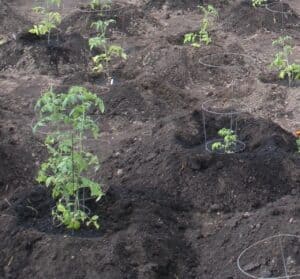
Floating raised bed (gravel sandwich base: landscape fabric, medium gravel, landscape fabric): this is a shallow bed separate from suspect ground-soil or on a cement or asphalt pad, so plant the seedling at the same level. This is also the only place I would consider trench planting (e.g., planting the tomato seedling lying down horizontally in a trench with only the head up); however, it is not necessary. Elsewhere, trench planting is not recommended as it encourages shallow roots which can lead to severe water problems and blossom end rot. If you have the root room vertically, best to use it for tomatoes. Note: Tomatoes are heavy drinkers and heavy feeders. They take a lot of root room, and they must never dry out.
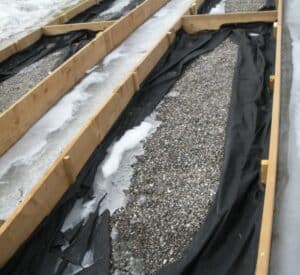
Happy Gardening!
DTE Notebook Tomato series: starting, transplanting, maintenance, disease & stress, seed saving.